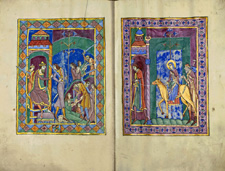Image
© Hildesheim, St Godehard |
THE MASSACRE
OF THE INNOCENTS
Matthew 2: 16-18
The measured serenity of the preceding miniatures gives no warning of
the unbridled violence in this scene. It is a conflation of two episodes,
divided by the central tree. The sword bearer or armiger provides the
moving link by looking backwards at Herod and walking forwards into the
mayhem. His pointing finger, echoing Herod’s, transfers the king’s
instructions into action. Some of the women helplessly weep and scream
but two, at the top right and bottom, try to fight back.
The division of this scene into two episodes, Herod giving his orders
and soldiers carrying them out, is a Byzantine feature, clearly illustrated
in the mosaics of Monreale. It also occurs in an Anglo-Saxon marginal
drawing in the Psalter from Bury St Edmunds (Vatican MS Reg. Lat. 12,
f87v) where there is similarly one significant armiger.
The single armiger is a much more significant character in liturgical
drama. The Massacre of the Innocents developed from an epilogue in the
play of the Magi into a separate piece, the Ordo Rachelis, named
after Rachael ‘weeping for her children’. In the Fleury play
book the armiger suggests the massacre himself, in order to appease Herod’s
wrath. Iconographically, this would justify his position in the centre
of the picture (AP, 85).
The Latin liturgical plays tend to dwell on the helpless misery of the
mothers, the unconsolable weeping of Rachael. However, the theme of defiant
mothers fighting back gradually develops from the twelfth century onwards.
It is particularly explicit in later vernacular dramas but occurs in art
as well. On the north tympanum of Notre Dame, Paris, c.1250, a mother
tries to grasp the point of a sword with her bare hand. In the Chester
'Gouldsmythes Playe' the mothers lay about the soldiers, attacking them
with rocks and distaffs. (Oosterwijk, forthcoming). This early appearance
of the defiant mothers in the St Albans Psalter may be yet another example
of iconographical innovation developing from dramatic performance.
Quire 2.
Thread or stitch holes for protective curtain

Click
to enlarge
|
![]()